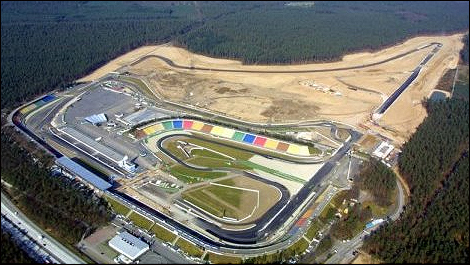Jul
18th
Stay connected Subscribe to our RSS feed
From Renault Sport F1
The 2012 FIA Formula One World Championship reaches its halfway point this weekend with round 10 of the 20-event calendar, the German Grand Prix.
This year the race is held at Hockenheim as part of a year-by-year rotation between the central German track and the Nürburgring.
The engineers of Renault Sport F1 tell us the challenges of the German circuit.
The Hockenheimring is above average when it comes to engine demands, featuring a higher than average power sensitivity. The average speed is 225kph, with approximately 65% of the 4.574km circuit spent at full throttle. Drivers reach over 290kph on three occasions (or over 300kph on two occasions) during the first part of the lap; down the start-finish straight, between the first and second corners and then again on the Parabolika straight.
The curved Parabolika straight is over 1km long, putting it on a par with the longer straights of the season (China, Abu Dhabi and Korea). In fact, the RS27 V8 engine will spend over 14 seconds at full throttle, one of the longest single outright times of the year.
The latter part of the lap, which includes a slow 60kph hairpin, a right hand flick and then the renowned stadium section, is taken at a much lower average speed. The tight, twisty nature of this part of the track demands good braking stability and engine torque response, particularly through the stadium, which is taken at an average of 200kph.
Normally conditions are very hot in Hockenheim, which results in a phenomenon known as engine acoustic offset. This means that the engine tunes at a higher engine speed. It is possible to change the inlet trumpets to offset this effect, and bring back the tune into the normal operating range.
The temperatures look like they are going to be cooler this year, with an average of 20°C predicted over the course of the weekend. As a result, it might not be necessary to fit these longer trumpets. However, the air density will be higher, which will increase the in-cylinder combustion pressures during the three long straights.
Alongside Melbourne and Valencia, Hockenheim produces one of the highest per kilometre fuel consumption rates of the year. The big stops of the hairpins and the twisty infield section increase the consumption dramatically and the starting fuel load will be one of the heaviest of the season.
The 2012 FIA Formula One World Championship reaches its halfway point this weekend with round 10 of the 20-event calendar, the German Grand Prix.
This year the race is held at Hockenheim as part of a year-by-year rotation between the central German track and the Nürburgring.
The engineers of Renault Sport F1 tell us the challenges of the German circuit.
 |
| The circuit of Hockenheim. (Photo: Renault Sport F1) |
The Hockenheimring is above average when it comes to engine demands, featuring a higher than average power sensitivity. The average speed is 225kph, with approximately 65% of the 4.574km circuit spent at full throttle. Drivers reach over 290kph on three occasions (or over 300kph on two occasions) during the first part of the lap; down the start-finish straight, between the first and second corners and then again on the Parabolika straight.
The curved Parabolika straight is over 1km long, putting it on a par with the longer straights of the season (China, Abu Dhabi and Korea). In fact, the RS27 V8 engine will spend over 14 seconds at full throttle, one of the longest single outright times of the year.
The latter part of the lap, which includes a slow 60kph hairpin, a right hand flick and then the renowned stadium section, is taken at a much lower average speed. The tight, twisty nature of this part of the track demands good braking stability and engine torque response, particularly through the stadium, which is taken at an average of 200kph.
Normally conditions are very hot in Hockenheim, which results in a phenomenon known as engine acoustic offset. This means that the engine tunes at a higher engine speed. It is possible to change the inlet trumpets to offset this effect, and bring back the tune into the normal operating range.
The temperatures look like they are going to be cooler this year, with an average of 20°C predicted over the course of the weekend. As a result, it might not be necessary to fit these longer trumpets. However, the air density will be higher, which will increase the in-cylinder combustion pressures during the three long straights.
Alongside Melbourne and Valencia, Hockenheim produces one of the highest per kilometre fuel consumption rates of the year. The big stops of the hairpins and the twisty infield section increase the consumption dramatically and the starting fuel load will be one of the heaviest of the season.
 The latest auto news, reviews, prices, product and vehicle releases.
The latest auto news, reviews, prices, product and vehicle releases.